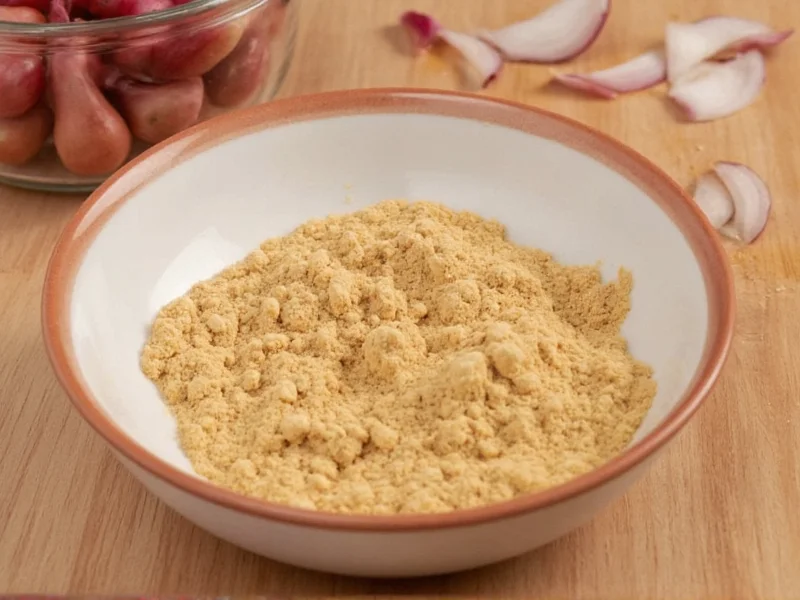Understanding how to properly convert between onion powder and fresh onions is essential for consistent cooking results. Many home chefs encounter recipe challenges when they need to substitute one form for another, whether due to pantry limitations or specific dietary requirements. Getting these conversions right affects not only flavor balance but also texture and overall dish success.
Understanding Onion Powder and Fresh Onion Differences
Before diving into conversion specifics, it's important to recognize the fundamental differences between these onion forms. Onion powder is dehydrated, concentrated onion that delivers intense flavor in a small volume. Fresh onions contain approximately 89% water, which significantly impacts their volume and potency compared to their dried counterparts.
The dehydration process concentrates the onion's natural compounds, making powder substantially more potent by volume. This concentration explains why you need far less powder than fresh onion to achieve similar flavor intensity. Additionally, the drying process alters certain sulfur compounds, creating subtle flavor differences between fresh and powdered forms.
Precise Onion Powder to Fresh Onion Conversion Chart
| Onion Powder Measurement | Equivalent Fresh Onion | Approximate Raw Weight |
|---|---|---|
| 1 teaspoon | 1/8 medium onion | 20 grams |
| 2 teaspoons | 1/4 medium onion | 40 grams |
| 1 tablespoon | 1/2 medium onion | 80 grams |
| 2 tablespoons | 1 medium onion | 160 grams |
| 1/4 cup | 2 medium onions | 320 grams |
Practical Substitution Guidelines for Cooking
When substituting onion powder for fresh onions in recipes, consider these professional kitchen insights:
- Liquid adjustment: Since onion powder lacks moisture, you may need to add 1-2 tablespoons of water per tablespoon of powder to maintain recipe hydration
- Flavor development: Add onion powder early in cooking to allow flavors to bloom, unlike fresh onions which often benefit from sautéing first
- Recipe suitability: Powder works best in soups, stews, rubs, and sauces where texture matters less
- Taste as you go: Onion potency varies by brand and storage conditions, so adjust to taste after initial conversion
When Not to Substitute Onion Powder for Fresh Onions
Certain recipes simply don't translate well with powder substitutions. Recognize these situations where fresh onions deliver irreplaceable qualities:
- Raw applications: Fresh salsas, salads, and garnishes where texture and crispness matter
- Caramelization-dependent dishes: French onion soup or dishes relying on the Maillard reaction from sliced onions
- Balanced moisture recipes: Batters and doughs where precise water content affects structure
- Visual presentation: Dishes where onion pieces provide visual appeal and textural contrast
Storage Considerations Affecting Conversion Accuracy
The age and storage conditions of your onion powder significantly impact its potency. Properly stored in an airtight container away from light and heat, onion powder maintains peak flavor for 2-3 years. Beyond this timeframe, you may need to increase the amount by 25-50% to achieve equivalent flavor.
Fresh onions stored in a cool, dry place maintain consistent potency for 1-2 months, though sweet varieties have shorter shelf lives. Always use firm, blemish-free onions for the most reliable conversion results.
Advanced Conversion Techniques for Professional Results
Experienced cooks employ these nuanced approaches when converting between onion forms:
- Layered flavor approach: Combine 75% onion powder with 25% fresh minced onion for depth in long-cooked dishes
- Rehydration method: Mix powder with equal parts warm water and let sit for 10 minutes before using for more fresh-like texture
- Acid balancing: Add a pinch of sugar when using powder in tomato-based dishes to counter increased acidity perception
- Temperature adjustment: Reduce powder by 25% in slow-cooked dishes where flavors concentrate over time
Common Conversion Mistakes to Avoid
Many home cooks make these critical errors when substituting onion forms:
- Using equal volumes without accounting for concentration differences
- Adding powder at the same cooking stage as fresh onions
- Not adjusting liquid content in the recipe
- Using expired powder without compensating for flavor loss
- Substituting in recipes where texture is essential to the dish
Special Considerations for Different Onion Varieties
While yellow onions form the basis for most commercial onion powder, specialty powders exist:
- Red onion powder: Slightly milder, use 10% more than standard conversion
- Shallot powder: More delicate flavor, use 25% less than standard conversion
- Garlic-onion blends: Adjust for additional garlic flavor when substituting
Frequently Asked Questions
Can I substitute onion powder for fresh onions in all recipes?
No, onion powder works best in cooked dishes like soups, stews, and sauces. Avoid substituting in raw applications, caramelization-dependent dishes, or recipes where onion texture is essential to the final dish.
How much onion powder equals one small onion?
One small onion (approximately 100g) equals 1.5 tablespoons of onion powder. For precise measurement, use 1 tablespoon of powder for every 100 grams of fresh onion weight.
Why does my dish taste too strong when using onion powder?
Onion powder is significantly more concentrated than fresh onions. You likely used too much - remember that 1 tablespoon of powder equals one medium fresh onion, not the other way around. Start with less powder and adjust to taste.
Does onion powder have the same nutritional value as fresh onions?
No, the dehydration process concentrates certain compounds while reducing others. Onion powder has higher concentrations of sulfur compounds per volume but loses some vitamin C and water-soluble nutrients during drying.
How do I adjust recipes when using expired onion powder?
For onion powder older than 2 years, increase the amount by 25-50% to compensate for flavor loss. Always smell your powder first - if it has little aroma, you'll need to use more or replace it entirely.











 浙公网安备
33010002000092号
浙公网安备
33010002000092号 浙B2-20120091-4
浙B2-20120091-4